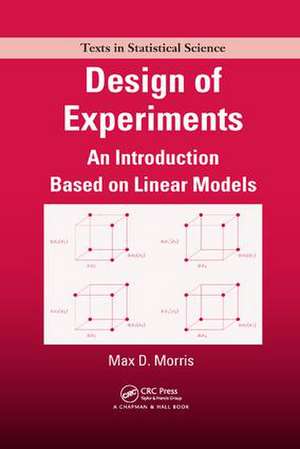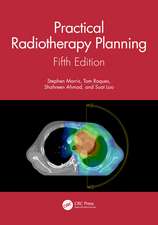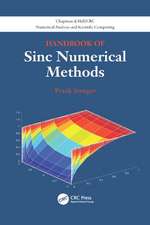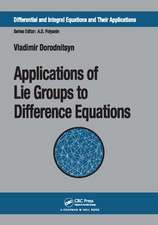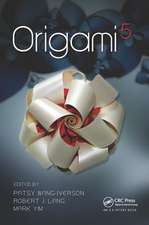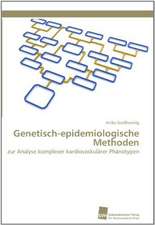Design of Experiments: An Introduction Based on Linear Models: Chapman & Hall/CRC Texts in Statistical Science
Autor Max Morrisen Limba Engleză Paperback – 31 mai 2017
The core material can be found in the first thirteen chapters. These chapters cover a review of linear statistical models, completely randomized designs, randomized complete blocks designs, Latin squares, analysis of data from orthogonally blocked designs, balanced incomplete block designs, random block effects, split-plot designs, and two-level factorial experiments. The remainder of the text discusses factorial group screening experiments, regression model design, and an introduction to optimal design. To emphasize the practical value of design, most chapters contain a short example of a real-world experiment. Details of the calculations performed using R, along with an overview of the R commands, are provided in an appendix.
This text enables students to fully appreciate the fundamental concepts and techniques of experimental design as well as the real-world value of design. It gives them a profound understanding of how design selection affects the information obtained in an experiment.
| Toate formatele și edițiile | Preț | Express |
|---|---|---|
| Paperback (1) | 582.50 lei 6-8 săpt. | |
| CRC Press – 31 mai 2017 | 582.50 lei 6-8 săpt. | |
| Hardback (1) | 1389.21 lei 6-8 săpt. | |
| CRC Press – 27 iul 2010 | 1389.21 lei 6-8 săpt. |
Din seria Chapman & Hall/CRC Texts in Statistical Science
- 5%
 Preț: 650.11 lei
Preț: 650.11 lei - 9%
 Preț: 579.76 lei
Preț: 579.76 lei - 8%
 Preț: 547.81 lei
Preț: 547.81 lei - 5%
 Preț: 838.33 lei
Preț: 838.33 lei - 9%
 Preț: 595.18 lei
Preț: 595.18 lei - 9%
 Preț: 623.03 lei
Preț: 623.03 lei - 8%
 Preț: 544.76 lei
Preț: 544.76 lei - 9%
 Preț: 641.61 lei
Preț: 641.61 lei - 8%
 Preț: 508.20 lei
Preț: 508.20 lei - 8%
 Preț: 551.99 lei
Preț: 551.99 lei - 9%
 Preț: 1115.11 lei
Preț: 1115.11 lei - 9%
 Preț: 641.93 lei
Preț: 641.93 lei -
 Preț: 341.43 lei
Preț: 341.43 lei - 8%
 Preț: 536.31 lei
Preț: 536.31 lei -
 Preț: 357.60 lei
Preț: 357.60 lei - 8%
 Preț: 444.54 lei
Preț: 444.54 lei - 9%
 Preț: 578.22 lei
Preț: 578.22 lei -
 Preț: 371.71 lei
Preț: 371.71 lei - 9%
 Preț: 806.41 lei
Preț: 806.41 lei - 9%
 Preț: 602.46 lei
Preț: 602.46 lei - 9%
 Preț: 593.61 lei
Preț: 593.61 lei - 9%
 Preț: 608.09 lei
Preț: 608.09 lei - 8%
 Preț: 496.58 lei
Preț: 496.58 lei - 9%
 Preț: 610.94 lei
Preț: 610.94 lei - 20%
 Preț: 541.42 lei
Preț: 541.42 lei -
 Preț: 355.66 lei
Preț: 355.66 lei - 8%
 Preț: 516.75 lei
Preț: 516.75 lei -
 Preț: 349.10 lei
Preț: 349.10 lei - 9%
 Preț: 568.64 lei
Preț: 568.64 lei - 8%
 Preț: 465.05 lei
Preț: 465.05 lei - 9%
 Preț: 580.81 lei
Preț: 580.81 lei - 9%
 Preț: 617.41 lei
Preț: 617.41 lei - 9%
 Preț: 595.91 lei
Preț: 595.91 lei -
 Preț: 388.08 lei
Preț: 388.08 lei -
 Preț: 356.64 lei
Preț: 356.64 lei - 8%
 Preț: 547.38 lei
Preț: 547.38 lei - 9%
 Preț: 599.19 lei
Preț: 599.19 lei -
 Preț: 316.73 lei
Preț: 316.73 lei - 9%
 Preț: 638.87 lei
Preț: 638.87 lei -
 Preț: 349.46 lei
Preț: 349.46 lei -
 Preț: 372.50 lei
Preț: 372.50 lei - 8%
 Preț: 439.81 lei
Preț: 439.81 lei - 11%
 Preț: 686.52 lei
Preț: 686.52 lei - 8%
 Preț: 510.14 lei
Preț: 510.14 lei - 8%
 Preț: 511.07 lei
Preț: 511.07 lei - 8%
 Preț: 563.73 lei
Preț: 563.73 lei - 18%
 Preț: 713.39 lei
Preț: 713.39 lei - 15%
 Preț: 684.84 lei
Preț: 684.84 lei - 22%
 Preț: 371.94 lei
Preț: 371.94 lei
Preț: 582.50 lei
Preț vechi: 685.29 lei
-15% Nou
Puncte Express: 874
Preț estimativ în valută:
111.47€ • 119.19$ • 92.93£
111.47€ • 119.19$ • 92.93£
Carte tipărită la comandă
Livrare economică 17 aprilie-01 mai
Preluare comenzi: 021 569.72.76
Specificații
ISBN-13: 9781138111783
ISBN-10: 1138111783
Pagini: 376
Ilustrații: 13
Dimensiuni: 156 x 234 x 25 mm
Greutate: 0.38 kg
Ediția:1
Editura: CRC Press
Colecția Chapman and Hall/CRC
Seria Chapman & Hall/CRC Texts in Statistical Science
ISBN-10: 1138111783
Pagini: 376
Ilustrații: 13
Dimensiuni: 156 x 234 x 25 mm
Greutate: 0.38 kg
Ediția:1
Editura: CRC Press
Colecția Chapman and Hall/CRC
Seria Chapman & Hall/CRC Texts in Statistical Science
Public țintă
UndergraduateCuprins
Introduction. Linear Statistical Models. Completely Randomized Designs. Randomized Complete Blocks and Related Designs. Latin Squares and Related Designs. Some Data Analysis for CRDs and Orthogonally Blocked Designs. Balanced Incomplete Block Designs. Random Block Effects. Factorial Treatment Structure. Split-Plot Designs. Two-Level Factorial Experiments: Basics. Two-Level Factorial Experiments: Blocking. Two-Level Factorial Experiments: Fractional Factorials. Factorial Group Screening Experiments. Regression Experiments: First-Order Polynomial Models. Regression Experiments: Second-Order Polynomial Models. Introduction to Optimal Design. Appendices. References. Index.
Notă biografică
Max D. Morris is a professor in the Department of Statistics and the Department of Industrial and Manufacturing Systems Engineering at Iowa State University. A fellow of the American Statistical Association, Dr. Morris is a recipient of the National Institute of Statistical Sciences Sacks Award for Cross-Disciplinary Research and the American Society for Quality Wilcoxon Prize.
Recenzii
A distinctive feature of this excellent book is that it actually focuses on how to design an experiment. … In all, an original and very useful book for students and instructors.
—Stat Papers (2014) 55:1225–1226
the author has succeeded in striking a balance between the choice of topics and depth in discussion for teaching a course. The book is written with a refreshing style and succeeds in conveying the concepts to a reader. The treatment of the subject matter is thorough and the theory is clearly illustrated along with worked examples. Other books are available on similar topics but this book has the advantage that the chapters start with the classical non-matrix-theory approach to introduce the linear model and then converts it into a matrix theory-based linear model. This helps a reader, particularly a beginner, in clearly understanding the transition from a non-matrix approach to a matrix approach and to apply the results of matrix theory over linear models further.
—Shalabh, Journal of the Royal Statistical Society, Series A, 2012
Overall, this is a book that is easy to like, with good definitions of designs, few typographical errors, and consistent, straightforward explications of the models … I can picture a lot of students using a text aimed at a broad market design course but who need to understand more about what is going on behind the curtain. Morris’ text also fills that gap very well.
—Gary W. Oehlert, Biometrics, May 2012
It is truly my pleasure to read this book … after reading this book, I benefitted by gaining insights into the modeling aspect of experimental design, and consequentially it helps me appreciate the idea of statistical efficiency behind each design and understand the tools used in data analysis. … an excellent reference book that I would recommend to anyone who is serious about learning the nuts and bolts of experimental design and data analysis techniques.
—Rong Pan, Journal of Quality Technology, Vol. 43, No. 3, July 2011
—Stat Papers (2014) 55:1225–1226
the author has succeeded in striking a balance between the choice of topics and depth in discussion for teaching a course. The book is written with a refreshing style and succeeds in conveying the concepts to a reader. The treatment of the subject matter is thorough and the theory is clearly illustrated along with worked examples. Other books are available on similar topics but this book has the advantage that the chapters start with the classical non-matrix-theory approach to introduce the linear model and then converts it into a matrix theory-based linear model. This helps a reader, particularly a beginner, in clearly understanding the transition from a non-matrix approach to a matrix approach and to apply the results of matrix theory over linear models further.
—Shalabh, Journal of the Royal Statistical Society, Series A, 2012
Overall, this is a book that is easy to like, with good definitions of designs, few typographical errors, and consistent, straightforward explications of the models … I can picture a lot of students using a text aimed at a broad market design course but who need to understand more about what is going on behind the curtain. Morris’ text also fills that gap very well.
—Gary W. Oehlert, Biometrics, May 2012
It is truly my pleasure to read this book … after reading this book, I benefitted by gaining insights into the modeling aspect of experimental design, and consequentially it helps me appreciate the idea of statistical efficiency behind each design and understand the tools used in data analysis. … an excellent reference book that I would recommend to anyone who is serious about learning the nuts and bolts of experimental design and data analysis techniques.
—Rong Pan, Journal of Quality Technology, Vol. 43, No. 3, July 2011
Descriere
Offering deep insight into the connections between design choice and the resulting statistical analysis, this text explores how experiments are designed using the language of linear statistical models. It presents an organized framework for understanding the statistical aspects of experimental design as a whole within the structure provided by general linear models. The text describes specific forms or classes of experimental designs, incorporates actual experiments drawn from the scientific and technical literature, and includes many end-of-chapter exercises. Calculations are performed using R, with commands provided in an appendix. A solutions manual is available upon qualified course adoption.
